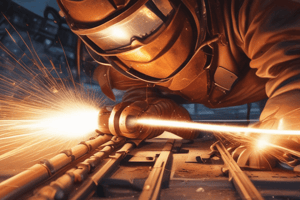Podcast
Questions and Answers
Why is it important to not over-tighten tips during oxy-acetylene cutting?
Why is it important to not over-tighten tips during oxy-acetylene cutting?
- To reduce the risk of leaks
- To increase the cutting speed
- To prevent damaging the seat (correct)
- To improve the quality of the cut
What is the purpose of the color-coded regulators in oxy-acetylene cutting equipment?
What is the purpose of the color-coded regulators in oxy-acetylene cutting equipment?
- To indicate the pressure level
- To control the flame temperature
- To differentiate between oxygen and fuel connections (correct)
- To adjust the cutting speed
Why should acetylene cylinders always be kept upright?
Why should acetylene cylinders always be kept upright?
- To reduce the overall weight
- To prevent leaks
- To improve the quality of the acetylene gas
- Due to the presence of liquid acetone and a porous membrane inside (correct)
What is the function of flashback arrestors in oxy-acetylene cutting torches?
What is the function of flashback arrestors in oxy-acetylene cutting torches?
Why is it recommended to wear appropriate clothing, eye protection, and gloves during oxy-acetylene cutting?
Why is it recommended to wear appropriate clothing, eye protection, and gloves during oxy-acetylene cutting?
What is a recommended tip for swapping out torch tips for different material thicknesses?
What is a recommended tip for swapping out torch tips for different material thicknesses?
Why is it crucial to maintain a safe distance while cutting with a torch?
Why is it crucial to maintain a safe distance while cutting with a torch?
What should be done to prevent accidents when using a rosebud for preheating and post-heating applications?
What should be done to prevent accidents when using a rosebud for preheating and post-heating applications?
How should oxy-acetylene welding equipment be wrapped up after use?
How should oxy-acetylene welding equipment be wrapped up after use?
Why should gas cylinders never be left freestanding according to the text?
Why should gas cylinders never be left freestanding according to the text?
Flashcards are hidden until you start studying
Study Notes
- Tutorial on oxy-acetylene cutting covering safety measures, equipment setup, selecting appropriate tips, and pressure adjustments.
- Color-coded regulators: green for oxygen, red for fuel, with specific fittings preventing incorrect connections.
- Importance of not over-tightening tips to avoid damaging the seat, and setting pressure based on tip size and material thickness.
- Acetylene cylinders should always be upright due to the presence of liquid acetone and a porous membrane inside.
- Checking for leaks using soapy water or shutting off valves to observe pressure changes.
- Fuse plugs on acetylene cylinders designed to melt at 220 degrees to prevent explosions in case of fire.
- Flashback arrestors and check valves built into torches or available externally to prevent flames from entering the lines.
- Safety measures including appropriate clothing, eye protection, and gloves to prevent burns from sparks and synthetic fibers melting.
- The importance of following safety protocols to avoid accidents and injuries during oxy-acetylene cutting.- Arc flash from bright light can cause keratitis, also known as welders' flash, which can happen without the person realizing.
- Recommended safety gear for cutting applications includes shade five to six goggles, IR5 safety glasses, and a face shield.
- Different types of flames in welding include neutral flame, carburizing flame (too much fuel), and oxidizing flame (too much oxygen).
- Tips for cleaning a welding torch tip include using a file to remove debris and cleaning out each port carefully.
- Maintaining a safe distance while cutting to prevent impurities from being sucked into the torch tip due to the venturi effect.
- Tips for cutting with a torch include cutting with intention by following a scribed line and using a stable hand position for clean, precise cuts.
- Swapping out torch tips for different material thicknesses requires adjusting the tip size and checking working pressures accordingly.
- Using a scarfing tip for flush cuts or rivet cutting, where the torch is held at an angle to avoid welding the material back together.
- Setting up and using a rosebud for preheating and post-heating applications, ensuring the correct tip size based on the acetylene tank capacity.
- Proper safety practices when using a rosebud include checking O-rings, setting working pressures, and bleeding the lines to prevent accidents.
- Steps for wrapping up oxy-acetylene welding equipment involve shutting off tanks, bleeding the lines, detaching the torch, and coiling the hoses properly for storage.- OSHA regulations require that if a gas system will be left set up for more than 24 hours, the entire system needs to be broken down and the gas cylinders need to be separated to prevent any issues.
- When handling gas bottles, always ensure that they have a cap on them or are secured to an appropriate cart to prevent accidents.
- Gas cylinders can be chained to a column, put in a bottle rack, or secured on an appropriate cart for lifting, but they should never be left freestanding.
- If there is no cart or column available, lean the gas cylinder on its side and wedge it securely to prevent rolling.
- When removing gas cylinders, remember that they have left-handed threads, so you need to turn them in the opposite direction (righty to loosen).
Studying That Suits You
Use AI to generate personalized quizzes and flashcards to suit your learning preferences.




